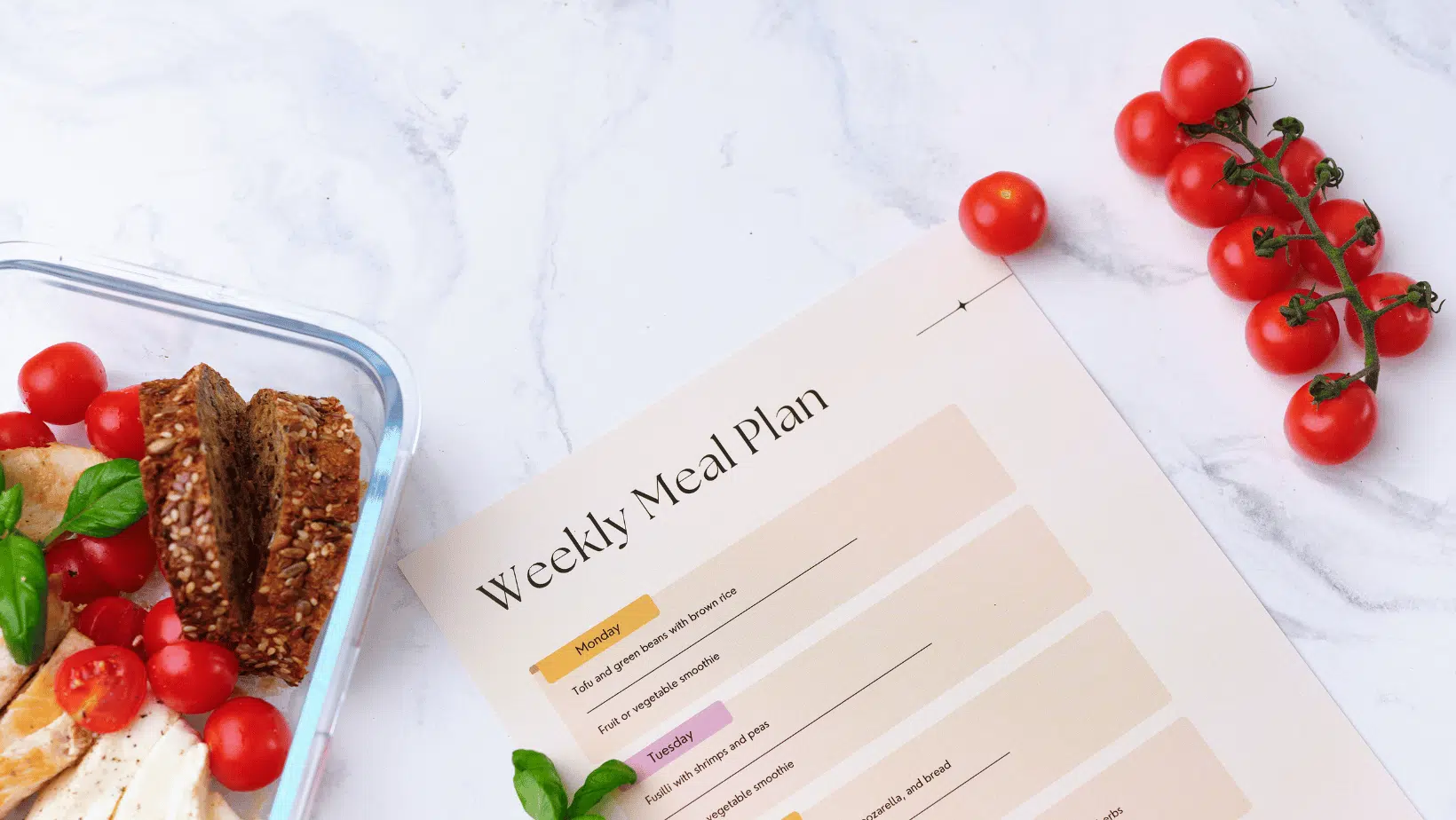Table of Contents
ToggleMeal planning can be one of the most arduous yet rewarding rituals for those striving for a healthier lifestyle. It is the cornerstone that supports nutritional goals, time management, and even a dash of financial planning. But where does one start? This comprehensive guide aims to take you from the grocery list rookie to the Iron Chef of your kitchen, all while keeping your health front and center.
So, why is a weekly meal plan so crucial? For busy professionals and health enthusiasts, the logic is simple – it saves time, reduces last-minute fast food fixes, ensures a balanced diet, and perhaps most importantly, simplifies your life. This guide is your passport to a week of savory, seamless meals, and it’s not just for the gourmet. It’s for anyone looking to make the most out of their kitchen and their day.
Step 1: Establish Your Goals
Before chopping a single vegetable, you need to set your compass. Identifying your goals will determine the direction of your meal plan. Are you aiming to lose weight, gain muscle, or increase your vegetable intake? Maybe you just want to save time. Here’s how to establish goals that stick.
Aim For Clarity
Unclear goals yield unsatisfactory outcomes. If ‘eating better’ is vague, try setting specific meal targets, such as incorporating grains and greens into lunch. The clearer the goal, the easier it is to plan for.
Evaluate Your Lifestyle
A meal plan that worked wonders for your marathon-running friend may not fit your life as a full-time parent or busy CEO. Take a realistic look at your schedule and work commitments.
Know Yourself
Understanding your triggers and temptations is crucial. If stress leads to comfort eating, include healthier comfort food alternatives in your plan. Tailor your plan to support your strengths and mitigate your weaknesses.
Step 2: Strategize Your Meals
Now that you know the ‘why,’ it’s time to figure out the ‘how.’ This step is all about finding which meal-planning method works best for you. Whether you prefer a rigid schedule, a versatile framework, or something in between, the key is to stick with it.
Choose Your Planning Style
From batching and prepping to cooking on the fly, there are numerous meal-planning styles to consider. Always keep in mind what will work best with your daily routine and personal operation systems.
Take Inventory
There’s nothing as disappointing as crafting a perfect plan and realizing you’ve got no olive oil. Regularly check your kitchen stock, noting what you have, what’s about to expire, and what needs replacing.
Add Some Spice to Your Life
Variety is the spice of life, and it’s no different in your meal plan. This is the time to experiment with new recipes, self-imposing the requirement to try at least one new dish per week.
Step 3: Draft a Shopping List
The start of all great meals is a trip to the grocery store. But with a list in hand and a plan in mind, this chore can be a breeze. Here’s how to make it so.
List by Category
Grouping your groceries by category makes your store trip efficient and reduces the chances of missing items. Canned goods together, produced in another group, you get the drift.
Health-Conscious Shopping
Making the healthier choice is simpler in the aisles than in the kitchen under a tide of temptation. Stock up on items rich in nutrients and low in artificial additions: fresh fruits, vegetables, lean meats, whole grains, and healthy fats.
Seasonal Savvy
Buying produce in season is budget-friendly and often more flavorful. Research what fruits and vegetables are in season in your region each week and incorporate them into your plan.
Step 4: Prepare and Cook
You’ve returned from the store, bags laden with the week’s necessities. Now comes the grunt work: prepping and cooking.
Time Blocks
Block out a chunk of time each week for meal prep and cooking. This can be done in stages or all at once, but be consistent. This will save a world of time during the hectic weekdays.
Streamline The Process
Develop an assembly-line approach to meal prep. Wash, chop, and organize your ingredients in one go. This batching method is the secret to faster prepping.
Tool Time
A well-stocked kitchen is a prepper’s dream. Equip yourself with a good set of knives, a food processor, and quality storage containers. These are your weapons in the fight against time.
Step 5: Store and Organize
You’ve poured your time and energy into the cooking – don’t let it go to waste. Proper storage will preserve the flavor and quality of your meals, allowing you to enjoy them throughout the week.
Pack It Right
The correct storage container can make a world of difference. Know which types are best for which foods to avoid soggy salads and bland soups. Label them for easy and safe identification.
Freezer, Meet Plan
Not everything can last a week in the fridge. Get familiar with which dishes freeze well to always have a backup plan.
Keep it Clean
An organized kitchen is key to efficient meal prep. Keep ingredients and prepared meals in clearly labeled containers, and clean as you go to avoid chaos in the kitchen.
Step 6: Review and Adjust
Your plan was not etched into stone. It’s okay to fail or grow tired of a dish. Flexibility is your friend; modify your plan to suit your evolving needs.
Reflect
At the end of each week, reflect on what worked and what didn’t. This will guide future meal plans and help build a repertoire of reliable recipes.
Listen To Your Body
Your body will tell you what it needs. If a specific meal didn’t quite cut it, adjust accordingly. Maybe you need more protein, a heavier lunch, or you’re bored with the same breakfast.
Evolve
As your life changes, so should your meal plan. Be ready to experiment with new recipes, dietary regimens, and even cultural cuisines. The only constant is change.
Understanding Dietary Needs and Preferences
We’re not all cut from the same cloth, and our meal plans won’t be either. This section delves into understanding and adapting to various dietary needs and preferences.
Allergies and Intolerances
For those with allergies or intolerances, it’s important to be aware of your triggers and ensure they are avoided in meals. This may involve substituting certain ingredients or finding alternative recipes.
Dietary Restrictions
Whether for religious or personal reasons, some individuals may have dietary restrictions that need to be considered when creating a meal plan. This may involve omitting certain foods or finding suitable alternatives.
Cultural Differences
Different cultures have different cuisines and dietary traditions. It’s important to be respectful and accommodating when creating meal plans for individuals from diverse cultural backgrounds. Researching and incorporating traditional dishes can add a unique touch to a meal plan. Overall, being aware of and adapting to various dietary needs and preferences is crucial to creating a successful and inclusive meal plan.
Time and Effort Considerations for Meal Planning
For those new to meal planning, it’s important to recognize and mitigate the potential time and effort that goes into creating your weekly menu. However, with some strategic planning and organization, it can become a manageable and even enjoyable task.
Start Small
Don’t try to plan an entire month’s worth of meals right off the bat. Begin with just one week at a time and gradually build up to longer periods.
Use Technology
Numerous meal-planning apps and websites are available that can help streamline the process and save time. Utilize these resources to your advantage.
Involve Others
If creating a meal plan for an entire family or household, get others involved in the planning process. This not only reduces the burden on one person but also creates a sense of shared responsibility and inclusion.
Make It Fun
Meal planning doesn’t have to be a tedious task. Experiment with new recipes, get creative with ingredients and involve friends or family in the cooking process. With some creativity and a positive attitude, meal planning can become an enjoyable part of your routine.
Understanding Nutritional Information
Knowing what’s on your plate is as critical as knowing how it got there. This part guides you through interpreting nutritional labels and the essential nutrients you need daily.
Read the Labels
Understanding how to read a nutritional label is crucial for making informed decisions about your food choices. Pay attention to serving sizes, calories, and recommended daily values of various nutrients.
The Big Three: Carbs, Protein, and Fat
These macronutrients provide energy and are essential for a balanced diet. Aim to consume a combination of all three in each meal.
Vitamins and Minerals
While needed in smaller amounts, these micronutrients play a vital role in maintaining overall health. Be sure to include a variety of fruits and vegetables to meet your daily requirements.
Don't Forget Water
Staying hydrated is essential for proper bodily function. Aim to drink at least eight glasses of water per day, or more if you are physically active or live in a hot climate.
Adding Variety to Meal Plans
The spice of variety should be sprinkled through not just your dishes, but the plan itself. This part shares how to make even the most regimented weekly menu a flavorful journey.
Mix up Your Protein
Don’t stick to the same protein sources every week. Incorporate a variety of meat, poultry, seafood, beans, and tofu for both taste and nutritional benefits.
Embrace Seasonal Produce
Not only is it more cost-effective to cook with seasonal produce, but it also ensures you are getting the freshest and most flavorful ingredients possible.
Experiment with Spices and Herbs
Don’t be afraid to get creative with seasonings! Adding different herbs and spices can completely transform a dish and add variety to your meals.
Try New Cuisines
There’s a whole world of flavors out there waiting to be explored. Don’t limit yourself to just one type of cuisine; try new dishes from different cultures to add excitement and variety to your meal plan.
Effective Meal Prep and Storage Tips
You may have all the ingredients, but if you don’t store and prep them correctly, your meals can suffer. Discover novel ways to keep your food fresh and enjoyable.
Invest in Storage Containers
Having a variety of storage containers in different sizes and shapes can make meal prep and storage more efficient. Look for BPA-free options that are microwave and dishwasher-safe.
Label Everything
Make sure to label your containers with the meal name, date, and any reheating instructions to avoid confusion or spoilage.
Plan Out Prep Times
Allocating specific times for meal preparation can make the process more manageable and less time-consuming. Dedicate a few hours one or two days a week to chop vegetables, marinate proteins, and cook large batches of staples like rice and pasta. This organized approach ensures that when it’s time to cook, you have everything ready to go, reducing daily effort and streamlining the cooking process.
Store Properly
Different foods have different storage requirements, so it’s essential to understand how to store them correctly. For example, cooked meats should be kept on the top shelf of the fridge, while raw meat should be stored on the bottom shelf to avoid cross-contamination. Fruits and vegetables that produce ethylene gas, like apples and avocados, should be stored separately from produce that is sensitive to it, like leafy greens and berries.
Budget-friendly Meal Planning
It’s a myth that healthy meal planning breaks the bank. Learn how to plan healthy, budget-friendly meals without compromising taste or nutrition.
Plan Around Sales
Take advantage of sales at your local grocery store when planning meals. Create your menu based on what’s on sale or look for coupons and discounts to save money.
Shop in Bulk
Buying items in bulk can often be more cost-effective, especially for staples like rice, beans, and other dry goods. Consider purchasing a membership to a wholesale warehouse or shop at bulk bins in your local grocery store.
Utilize Frozen and Canned Foods
Don’t shy away from frozen or canned fruits and vegetables. They can be just as nutritious as fresh produce and are often more affordable. Look for options with no added sugar or salt.
Get Creative with Leftovers
Don’t let leftovers go to waste! Repurpose them into new meals or use them as ingredients for other dishes. This not only saves money but also adds variety to your meal plan.
Conclusion
By channeling your inner chef with a weekly meal plan, you’re not just cooking; you’re crafting a lifestyle. Embrace the process, from goal setting to the final bite, and feel the health, time, and financial benefits unfold on your plate.
Frequently Asked Questions
For those new to meal planning, the best approach is to start simple. Choose a few recipes that you enjoy and are comfortable making, and plan to prepare them for the week. Gradually introduce variety as you become more confident.
Ensure your meals include a good balance of macronutrients—carbohydrates, proteins, and fats—and a wide range of vitamins and minerals. Including a variety of food groups and colors on your plate is a practical method to achieve this.
Be flexible and have some backup options available, such as frozen meals or quick recipes that use pantry staples. This allows you to adapt when unforeseen changes arise without completely disrupting your meal plan.
Not necessarily. Healthy meal planning can be budget-friendly if you plan around sales, buy in bulk, utilize frozen and canned foods, and get creative with leftovers. It often leads to savings by reducing food waste and avoiding impulsive food purchases.
Absolutely. Meal planning is versatile and can be customized to accommodate any dietary restrictions or preferences. It requires a bit of research and adaptation of recipes to align with specific dietary requirements.
Investing in storage containers, labeling everything, planning out prep times, and storing food properly are all ways to make meal prep more efficient.








